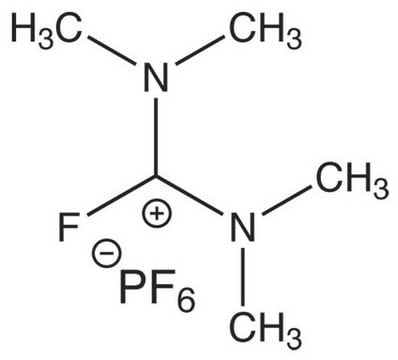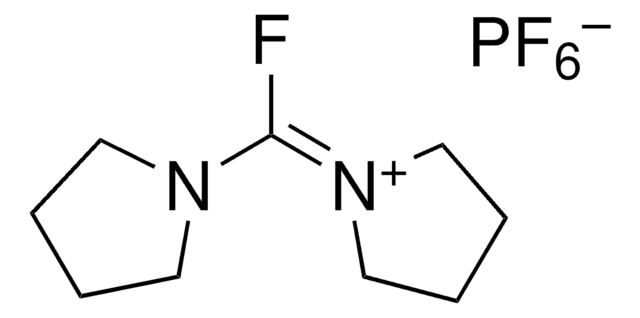77386
2-Bromo-1-ethyl-pyridinium tetrafluoroborate
≥97.0% (T)
Synonym(s):
BEP
Sign Into View Organizational & Contract Pricing
All Photos(1)
About This Item
Empirical Formula (Hill Notation):
C7H9BBrF4N
CAS Number:
Molecular Weight:
273.86
Beilstein:
4059265
EC Number:
MDL number:
UNSPSC Code:
12352005
PubChem Substance ID:
NACRES:
NA.22
Recommended Products
Quality Level
Assay
≥97.0% (T)
form
crystals
reaction suitability
reaction type: Coupling Reactions
mp
103-107 °C
application(s)
peptide synthesis
functional group
bromo
SMILES string
F[B-](F)(F)F.CC[n+]1ccccc1Br
InChI
1S/C7H9BrN.BF4/c1-2-9-6-4-3-5-7(9)8;2-1(3,4)5/h3-6H,2H2,1H3;/q+1;-1
InChI key
YJDXVQLBIAJTHP-UHFFFAOYSA-N
General description
2-Bromo-1-ethyl-pyridinium tetrafluoroborate is a coupling reagent employed in the synthesis of amides and esters through amidation and esterification reactions, respectively. It is generally prepared by the reaction of triethyloxonium tetrafluoroborate with 2?bromo pyridine.
Application
2-Bromo-1-ethyl-pyridinium tetrafluoroborate can be used as a coupling reagent for:
- The synthesis of N-methylated peptides in solution and solid phase.
- The synthesis of cyclosporin A fragment and dolastatin 15 pentapeptide moiety.
Other Notes
Coupling reagent for peptide synthesis; less racemization and faster reaction than with other reagents;e.g. BOP, PyBrOP, PyClU, BTFFH, CMBI
Storage Class Code
11 - Combustible Solids
WGK
WGK 3
Flash Point(F)
Not applicable
Flash Point(C)
Not applicable
Personal Protective Equipment
dust mask type N95 (US), Eyeshields, Gloves
Choose from one of the most recent versions:
Already Own This Product?
Find documentation for the products that you have recently purchased in the Document Library.
Customers Also Viewed
Ya-Ling Chou et al.
Journal of the Chinese Medical Association : JCMA, 82(6), 510-514 (2019-06-11)
Congenital TORCH (toxoplasmosis, other viruses [varicella-zoster virus, VZV, etc.], rubella, cytomegalovirus [CMV], Herpes simplex virus [HSV]) infections are major causes of prenatal, perinatal, and postnatal morbidity and mortality. Although treatment or prevention strategies are available for these pathogens, all drugs
Julien Lupo et al.
AIDS (London, England), 33(6), 993-1000 (2019-04-05)
Epstein-Barr virus (EBV) has been implicated in lymphomagenesis of HIV-related classical Hodgkin lymphoma (HIV-cHL). The utility of EBV molecular and serological biomarkers has scarcely been examined in HIV-cHL in the recent combined antiretroviral therapy (cART) era. We evaluated EBV DNA
Benjamin J Burwitz et al.
Nature communications, 8(1), 2146-2146 (2017-12-17)
Hepatitis B virus (HBV) is a major global health concern, and the development of curative therapeutics is urgently needed. Such efforts are impeded by the lack of a physiologically relevant, pre-clinical animal model of HBV infection. Here, we report that
Benjamin Gille et al.
SLAS technology, 23(2), 188-197 (2018-01-19)
The lack of (inter-)laboratory standardization has hampered the application of universal cutoff values for Alzheimer's disease (AD) cerebrospinal fluid (CSF) biomarkers and their transfer to general clinical practice. The automation of the AD biomarker immunoassays is suggested to generate more
K Clint Cary et al.
The Journal of urology, 193(2), 507-512 (2014-09-26)
Induction chemotherapy for International Germ Cell Cancer Collaborative Group (IGCCCG) good risk metastatic testicular cancer includes 3 cycles of bleomycin, etoposide and cisplatin (BEP x3) or 4 cycles of etoposide and cisplatin (EP x4). We examine differences in active cancer
Our team of scientists has experience in all areas of research including Life Science, Material Science, Chemical Synthesis, Chromatography, Analytical and many others.
Contact Technical Service









